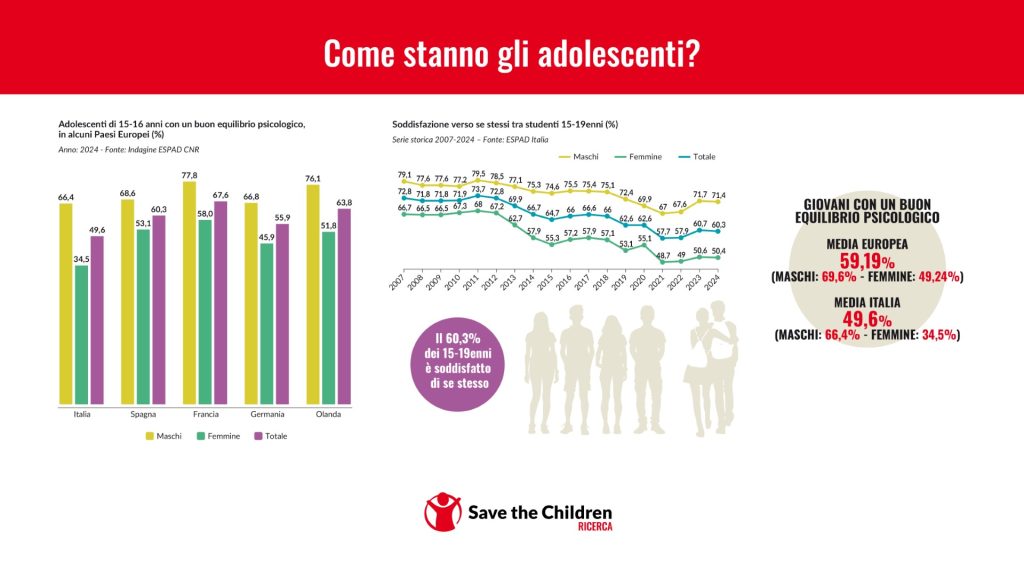Italy’s adolescents are living in an “onlife” world, where the digital and physical spheres merge. Save the Children’s 16th Atlas of Childhood (at Risk), released ahead of World Children’s Day, paints a complex picture.
Teenagers are hyperconnected yet often alone. They search for support in chatbots and algorithms, even as social and economic pressures deepen offline.
AI becomes an emotional outlet
More than 92% of 15–19 year-olds now use AI tools. Almost one in three uses them daily. What is new is the emotional reliance: 41.8% have turned to AI when feeling sad, lonely, or anxious, and over 42% have asked for advice on personal decisions.
Many say AI is “always available” and “non-judgmental”. Over 63% find interactions with AI more satisfying than with a real person at least some of the time. For Save the Children, this shift raises urgent questions about psychological support and the digital environments in which young people grow up.
Psychological wellbeing falls, girls hit hardest
Less than half of Italian 15–16 year-olds feel psychologically well. The gender gap is stark. Only 34% of girls report good psychological balance, compared with 66% of boys – the widest gap in Europe.
Risky behaviours mirror that strain. 9% of adolescents have isolated themselves because of psychological problems. Twelve percent have taken psychotropic drugs without a prescription, with far higher rates among girls. Body image remains a major pressure point: two in five 15-year-old girls believe they are “too fat”, although only 11% are overweight.
Poverty, parents, and the shrinking youth population
Italy’s teenage population continues to shrink. Today, just over four million 13–19 year-olds remain — one in 15 people. In 1983, the figure was one in nine. By 2050, numbers are set to fall below three million.
Economic pressure compounds that decline. More than one in four adolescents between 11 and 15 is at risk of poverty or social exclusion. Territorial gaps remain wide: 15.2% in the north, 24.1% in central regions, and 41.9% in the south. Food and energy poverty affect thousands, and 43% of families with adolescent children live in overcrowded homes.
Family structures are changing too. Nearly a quarter of teenagers live with a single parent, and 22% are only children. These shifts can intensify isolation and reduce support networks.
Digital life dominates but brings new vulnerabilities
Teenagers spend more time online than ever. Thirteen percent show signs of hyperconnection. More than a quarter feel nervous when separated from their phone. The social consequences are visible: 47.1% have been cyberbullied, a steep rise since 2018.
Offline habits tell another story of disconnection. Half of teenagers did not visit a museum in 2024. Nearly one in five does no physical activity. Reading rates continue to fall, especially in the south.
Yet friendships remain a stabilising force. More than eight in ten adolescents say they are satisfied with their relationships with friends. Most also report positive relationships with parents despite occasional conflict.
Strain on mental-health services
The report highlights inadequate support structures. Specialist child and adolescent neuropsychiatry units offer just over 400 beds nationwide. Several regions have none at all.
Post-hospital care faces similar shortages, with large regional discrepancies. The gaps raise the risk that young people will be treated in adult facilities or miss care entirely.
Also read: Use of psychiatric drugs among minors doubles in 8 years
What Save the Children is calling for
Save the Children argues that Italy must react quickly. The organisation stresses investment in mental-health services, education in relationships and sexuality, and community spaces where young people can meet and create. AI’s growing emotional role, it says, makes intergenerational dialogue essential.
The charity continues to run 27 Punto Luce centres and long-term neighbourhood projects in cities including Rome, Palermo, Naples, Prato and Turin. It supports youth movements and peer-to-peer initiatives focused on mental wellbeing.






